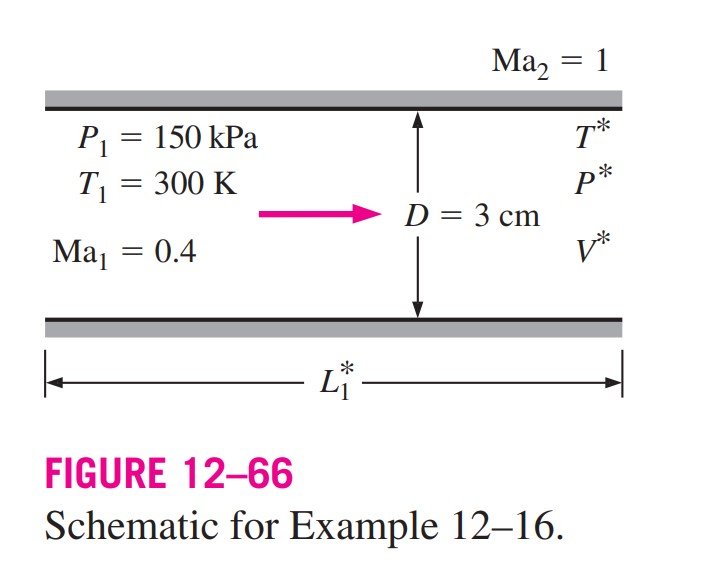Question 12.16: Choked Fanno Flow in a Duct Air enters a 3-cm-diameter smoot...
Choked Fanno Flow in a Duct
Air enters a 3-cm-diameter smooth adiabatic duct at Ma _{1}=0.4, T_{1}=300 K , and P_{1}=150 kPa (Fig. 12–66). If the Mach number at the duct exit is 1, determine the duct length and temperature, pressure, and velocity at the duct exit. Also determine the percentage of stagnation pressure lost in the duct.

Learn more on how we answer questions.
Air enters a constant-area adiabatic duct at a specified state and leaves at the sonic state. The duct length, exit temperature, pressure, velocity, and the percentage of stagnation pressure lost in the duct are to be determined.
Assumptions 1 The assumptions associated with Fanno flow (i.e., steady, frictional flow of an ideal gas with constant properties through a constant cross-sectional area adiabatic duct) are valid. 2 The friction factor is constant along the duct.
Properties We take the properties of air to be k=1.4, c_{p}=1.005 kJ / kg \cdot K , R=0.287 kJ / kg \cdot K , \text { and } \nu=1.58 \times 10^{-5} m ^{2} / s .
Analysis We first determine the inlet velocity and the inlet Reynolds number,
\begin{gathered}c_{1}=\sqrt{k R T_{1}}=\sqrt{(1.4)(0.287 kJ / kg \cdot K )(300 K )\left(\frac{1000 m ^{2} / s ^{2}}{1 kJ / kg }\right)}=347 m / s \\V_{1}= Ma _{1} c_{1}=0.4(347 m / s )=139 m / s \\\operatorname{Re}_{1}=\frac{V_{1} D}{\nu}=\frac{(139 m / s )(0.03 m )}{1.58 \times 10^{-5} m ^{2} / s }=2.637 \times 10^{5}\end{gathered}
The friction factor is determined from the Colebrook equation,
\frac{1}{\sqrt{f}_{f}}=-2.0 \log \left(\frac{\varepsilon / D}{3.7}+\frac{2.51}{\operatorname{Re} \sqrt{f}}\right) \rightarrow \frac{1}{\sqrt{f}_{f}}=-2.0 \log \left(\frac{0}{3.7}+\frac{2.51}{2.637 \times 10^{5} \sqrt{f}}\right)
Its solution is
f = 0.0148
The Fanno flow functions corresponding to the inlet Mach number of 0.4 are (Table A–16):
\frac{P_{01}}{P_{0}^{*}}=1.5901 \quad \frac{T_{1}}{T^{*}}=1.1628 \quad \frac{P_{1}}{P^{*}}=2.6958 \quad \frac{V_{1}}{V^{*}}=0.4313 \quad \frac{f L_{1}^{*}}{D}=2.3085
Noting that * denotes sonic conditions, which exist at the exit state, the duct length and the exit temperature, pressure, and velocity are determined to be
\begin{aligned}L_{1}^{*} &=\frac{2.3085 D}{f}=\frac{2.3085(0.03 m )}{0.0148}=4.68 m \\T^{*} &=\frac{T_{1}}{1.1628}=\frac{300 K }{1.1628}=258 K \\P^{*} &=\frac{P_{1}}{2.6958}=\frac{150 kPa }{2.6958}=55.6 k P a \\V^{*} &=\frac{V_{1}}{0.4313}=\frac{139 m / s }{0.4313}= 3 2 2 m / s\end{aligned}
Thus, for the given friction factor, the duct length must be 4.68 m for the Mach number to reach Ma = 1 at the duct exit. The fraction of inlet stagnation pressure P_{01} lost in the duct due to friction is
\frac{P_{01}-P_{0}^{*}}{P_{01}}=1-\frac{P_{0}^{*}}{P_{01}}=1-\frac{1}{1.5901}=0.371 \quad \text { or } \quad 37.1 \%
Discussion This problem can also be solved using appropriate relations instead of tabulated values for the Fanno functions. Also, we determined the friction factor at the inlet conditions and assumed it to remain constant along the duct. To check the validity of this assumption, we calculate the friction factor at the outlet conditions. It can be shown that the friction factor at the duct outlet is 0.0121—a drop of 18 percent, which is large.
Therefore, we should repeat the calculation using the average value of the friction factor (0.0148 + 0.0121)/2 = 0.0135. This would give the duct length to be L_{1}^{*}=2.3085(0.03 m ) / 0.0135=5.13 m , and we take this to be the required duct length.